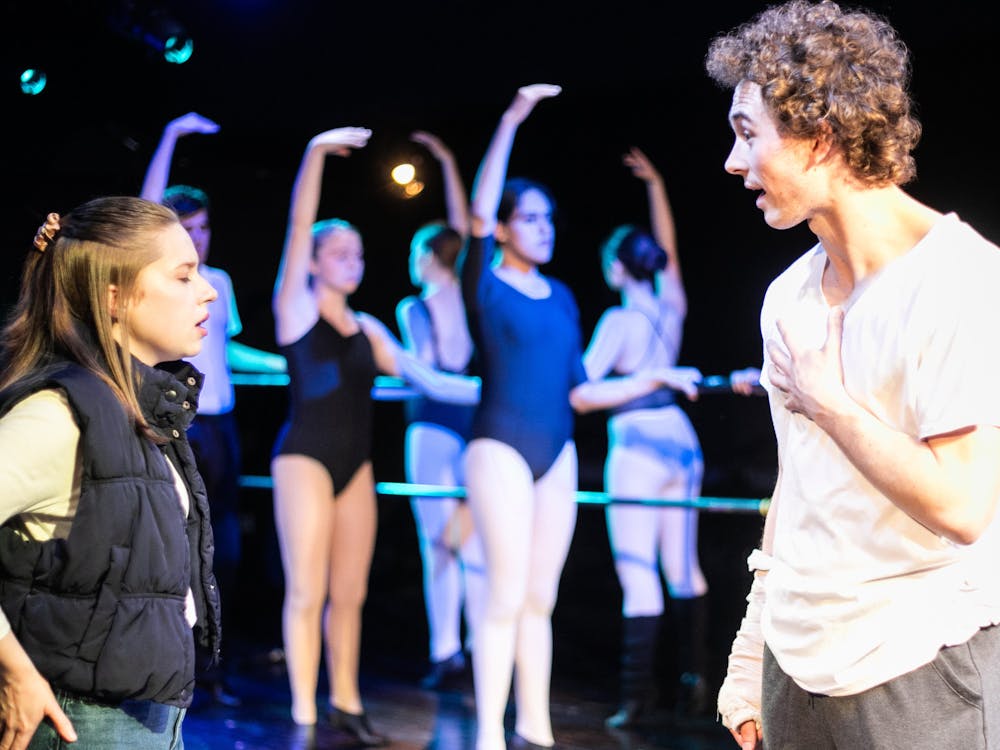From Mar. 27 to Mar. 30, Duke Players — a club affiliated with the Department of Theater Studies — put on Dance Nation in Brody Theater. The play was a powerful examination of the trials and tribulations of young adulthood and the equally divisive and supportive nature of competition.
Dance Nation follows a group of dancers — the play even includes several dances choreographed by Trinity junior Caroline Edmondson (who did double duty as director) — in their early teens. The group’s members consist of Connie (Trinity junior Umang Dhingra), Ashlee (Trinity sophomore Lilah Gorfain), Sofia (Trinity senior Lucy Law), Zuzu (Trinity sophomore Jackie Park), Maeve (Trinity senior Bess Pierre), Luke (UNC-Chapel Hill student Stokes Watkins) and Amina (Trinity senior Alexandria Edwards.) They are coached by Dance Teacher Pat (Trinity senior Connor Fogleman), an incredibly demanding coach who oscillates from kind and supportive to aggressive and ruthless.
Over the course of the play, the dancers prepare for, and ultimately compete in, a big show in Philadelphia. If successful there, they only have to win a few more shows before ultimately getting to the host city of the biggest contest in all of (young teen) dance - Tampa.
While the premise may seem insignificant, the young women — and man — of the team are obsessed with the goal, seeing a performance in Tampa as a chance to make it big and end up like the almost mythical Sabina, a former team member whose Tampa performance ultimately brought her to Broadway. Yet they are not all equally good dancers, something they are all too aware of.

Indeed, the team’s unity is constantly threatened by the fact that they know some performers are clearly better than others and are usually selected for all the good roles. For their next show, the dancers are putting on an incredibly ambitious act, yet Zuzu, the performer Pat picked for the leading role, is potentially their worst dancer and was only picked because of her mother’s request. The plot revolves around Zuzu’s struggles and the team’s dynamic as they prepare for their competition.
Ultimately, while there is a plot, this play is not about the story of some grand victory or devastating defeat. Instead, it is the story of a bunch of young women — and one man — figuring out who they are and what they want to be, complete with all the drama, joy and pain that comes with the process.
While they are each quite archetypal — the girl with an over-involved parent, the successful one struggling with her success, the girl who feels and is overlooked by everyone around her and so forth — they are simultaneously and paradoxically unique and fleshed out. This is in large part due to the efforts of their actors, who imbue the show with raw emotion and energy while giving performances that feel expert and authentic — a tall feat given that nearly every actor is playing someone under the age of 14.
One of the play’s most notable features, aside from its dance numbers, are its monologues and conversations. Several characters deliver powerful monologues, ranging in topic from Ashlee’s thoughts on her own body to Connie’s desire to get the main role and in style from sentimental prayers to Heaven to explicit exclamations of one’s love of their own body. The conversations between characters are often just as powerful, touching on everything from hopes and dreams to their fear of failure and being everything from loving to highly confrontational. The dialogue used feels authentic to the characters and while I have little experience with the types of conversations young women have amongst themselves, the way they talk with one another feels real.
These expert performances and well-written characters are paired with a purposefully sparse set design, expert choreography and simple yet strong lighting — all of which work together to center the characters and their experiences.
Something that struck me in particular was just how much the world of competitive dance parallels the worlds of other competitive youth sports like football and lacrosse. There is so much overlap, from often over competitive and brutal coaches to prodigies who struggle with the pressure placed on them to kids who desperately hope to be great but can only ever be good. While not everyone may have been a dancer or athlete, the types of dynamics the show encapsulates and the experiences it depicts are universal.
Overall, ‘Dance Nation’ took what seemed on the surface as a niche plot and transformed it into a universally-applicable coming-of-age story. While the play may no longer be running, its messages will live on for all those who watched it.
Get The Chronicle straight to your inbox
Sign up for our weekly newsletter. Cancel at any time.
Zev van Zanten is a Trinity junior and recess editor of The Chronicle's 120th volume.

